Berlin is the beating heart of Germany. The city perfectly combines its long and turbulent history with a modern energy. As you walk through its streets, you’ll uncover an architectural puzzle that mixes the old and the new in a fascinating way. Berlin’s skyline tells stories of resilience, transformation and artistic expression. From the historical landmarks that have stood the test of time to the sleek lines of avant-garde structures. The city’s architecture reflects the different chapters of its story. The monumental highlights to visit in Berlin include the iconic Brandenburg Gate, the majestic Reichstag, the Berlin Cathedral and more.
This post is written by guest blogger Matti from Tours of Berlin.
Table of Contents
The Brandenburg Gate
The Brandenburg Gate is an iconic monument that describes both the past struggles and current union of the city. The structure has a long historical and architectural significance. The gate has been a silent witness to the ups and downs of the German capital. Constructed on the orders of Prussian King Frederick William II, the Brandenburg Gate was built as a symbol of peace. Its neoclassical design was inspired by the Acropolis in Athens. It was an architectural respect to ancient Greece’s democratic ideals.
During its early years, the gate marked the start of the road from Berlin to the town of Brandenburg an der Havel. Its role as a gateway was double: it welcomed travellers arriving in Berlin and those leaving the city on a route that reflected the spread of Brandenburg-Prussia’s influence.
The Napoleonic Wars brought about a change in function for the Brandenburg Gate. It became a symbol of peace and victory. Following the fall of the Berlin Wall, the Gate stood as a symbol of the division within Germany but later became an icon of German unity. Particularly in 1989, when the gate opened for the first time in almost three decades.

Architectural design
The gate has an impressive arch with Corinthian orders and five passageways. Its design is based on the Propylaea. An ancient Greek gateway. It gives the structure an air of antiquity in the modern world. On top of the gate is the Quadriga, a chariot drawn by four horses. This sculpture, with its goddess of victory, once signified the military might of the kingdom.
Every element of the Brandenburg Gate’s design carries symbolism. The five passages, the Quadriga, and the various reliefs all have meanings that provide insight into the values and beliefs of the era in which it was built. Understanding these details enriches our appreciation of the gate as a masterpiece that marries art and history.
Time has not been gentle to the gate, and it has undergone several renovations. The Gate was damaged during World War II but was later restored to its former glory. Preserving the historical facade is a continuous effort that underlines the gate’s significance. The gate’s cultural significance extends to art, music, and literature. It has been immortalized in countless works that focus on the city of Berlin. The gate’s image often stands as a powerful metaphor for the spirit of the city and its history.
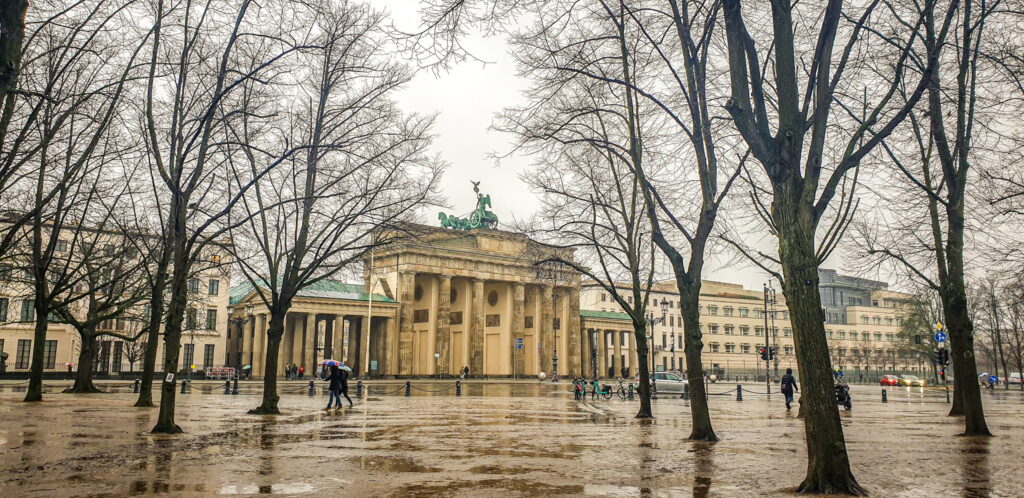
The Reichstag
The Reichstag was originally built in 1894 to house the Imperial Diet. It was the main legislative body of the German Empire. The building was designed by architect Paul Wallot and featured a grand neo-Renaissance style dome. The Reichstag served as the seat of government until the end of World War I. After Germany became a republic and the building was used as the seat of the parliament.
The fire of 1933
On February 27th, 1933 a fire broke out in the Reichstag. The fire destroyed much of the building and caused extensive damage. The Nazi party led by Adolf Hitler blamed the fire on the Communists. Hitler used the incident as an excuse to pass the Enabling Act. This Act gave Hitler dictatorial powers. The building was not used for parliamentary sessions for the 12 years of Nazi rule. In 1945 the building became a battleground and suffered extensive damage in the “Battle of Berlin”.
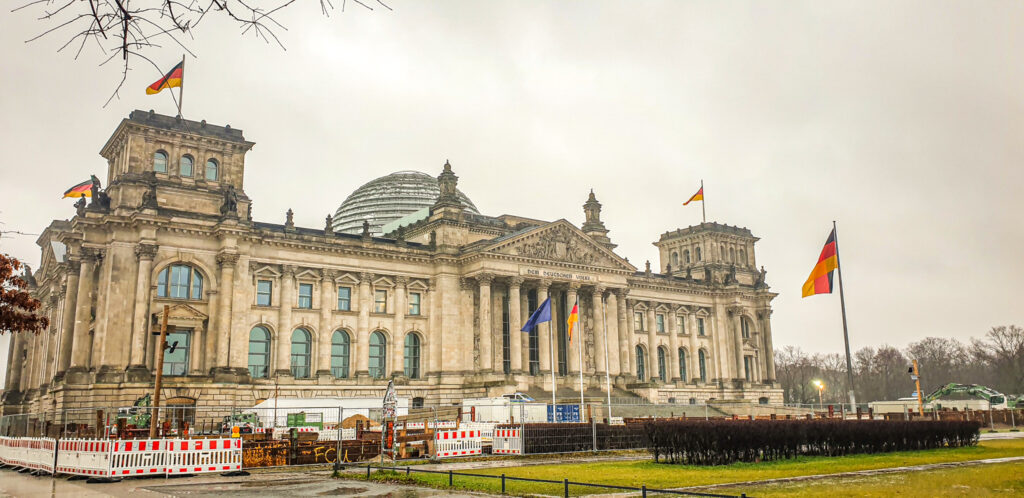
Reconstruction and renovation
After World War II the Reichstag was rebuilt and modernized to serve as the seat of the newly reunited German government. The building underwent a major renovation in the 1990s under the guidance of architect Norman Foster. He added a glass dome to the roof that offers stunning views of Berlin. The dome also serves as a symbol of transparency and openness in government.
The Band des Bundes
The concept of the “Bundesring” was founded during the 1950s. In the aftermath of World War II Germany was divided into two parts; a socialist East and a capitalist West. The idea was to build a highway encircling West Berlin to connect the city’s various sections. The highway would provide a bypass for travellers who couldn’t enter East Germany. Construction of the ring road began in 1960 and was completed eight years later. Since then the Band des Bundes has played a significant role in connecting West Berlin.
The landmarks along Band des Bundes
Once you start exploring the Federal beltway you’ll come across some of the most iconic landmarks of the city. The one landmark that stands out from the rest in Berlin’s skyline is the iconic television tower. The Fernsehturm. It’s located at Alexanderplatz. The Fernsehturm is 1200 feet tall and offers panoramic views of the city from its observation deck. Other technological buildings include the Funkturm radio tower in Charlottenburg. The Funkturm Radio Tower is listed as historical monument.
The Band des Bundes and the Berlin Wall
The Berlin Wall once divided the city and remains one of the most significant barriers in history. The 153 km-long wall separating East and West Berlin was erected in 1961. People lived under its shadow for decades. If you’re fortunate enough to explore Band des Bundes, you’ll notice how the wall and the Bundesring are linked. The Bundesring provided West Berliners a means of escape in case they wanted to flee East Berlin and vice versa. Along its route the Band des Bundes features several monuments commemorating the wall and those who lost their lives trying to flee from East to West.
The Band des Bundes today
After the country’s reunification the Band des Bundes lost some of its significance. It was no longer the only connection between East and West Berlin. But it remained one of the most important highways in Germany providing access to major cities like Hamburg, Cologne, and Frankfurt. Today the Band des Bundes witnesses traffic jams and delays during peak hours, but it still retains its reputation as a significant part of Berlin’s history.
Museum Island
Nestled gracefully along the banks of the River Spree the Museum Island is a testament to Berlin’s rich cultural and historicy. This UNESCO World Heritage site brings together five world-renowned museums like the Neues Museum, Altes Museum and the recently inaugurated Humboldt Forum.
Altes Museum
The museum’s main focus is on ancient Greek and Roman sculptures. Some sculptures are over 2,000 years old. One of the most impressive exhibits is the statue of the Greek hero Heracles (Hercules). You will also find the largest collection of ancient gold jewellery from the eastern Mediterannean on display. This collection includes treasure pieces from the ancient Persian Empire and precious pieces from other cultures.
In the basement of the museum you will find the coin cabinet, which is considered one of the best collections of ancient coins in the world. It holds over 500,000 ancient and medieval coins from all over the world. It is a haven for numismatists (coin collectors) and a treat for those interested in ancient currencies.
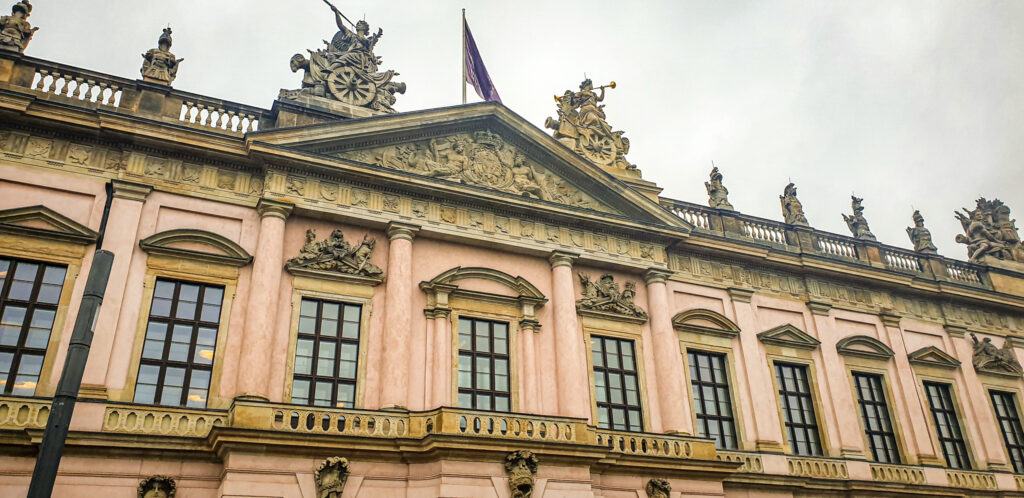
Neues Museum
The Neues Museum was initially opened in 1855. It was heavily bombarded during World War II and destroyed much of the collections. The renovation was led by architect David Chipperfield between 1997 and 2009. The architect’s ingenious work ensured that the Neues Museum strikes a perfect balance of historical preservation and modern design. It displays artefacts from the prehistoric and protohistoric cultures.
Alte Nationalgalerie
The Alte Nationalgalerie is housed in a stunning 19th-century neoclassical building. The gallery is home to an impressive collection of 19th-century artworks. Including paintings, sculptures, and drawings. You will get to see the works of some of the most renowned artists of the time, including Caspar David Friedrich, Adolph Menzel and Johan Christian Dahl.
The collection of artworks on display offers valuable insights into the cultural, social and political context of the time. Take some time to read the informative labels that accompany the artworks. They provide fascinating information about the artists, the techniques and styles they used. And of course the historical events that influenced their work.
Bode Museum
The Bode Museum is housed in a beautiful Baroque style building that was built in 1905. It was initially called the Kaiser Friedrich Museum. But the museum was renamed in 1956 after its former curator Wilhelm von Bode. The museum’s collection of Byzantine art is noteworthy. The collection includes pieces from the 3rd to the 15th century, including religious art, mosaics and icons. The collection is displayed chronologically and helps visitors understand the evolution of Byzantine art over time. The museums’ Islamic art collection is also impressive, with artefacts ranging from the 8th to the 19th century.
The sculpture collection at the Bode Museum is perhaps the most impressive of them all. The collection includes pieces from the Middle Ages to the 18th century. The sculptures are displayed in themed rooms that allow visitors to get a better understanding of the context in which they were created. The bronze room is a particular highlight, with its impressive collection of bronze sculptures from the Renaissance.
Pergamon Museum
The Pergamon Museum opened its doors to the public in 1930. It is named after the ancient Greek city of Pergamon. This city was known for its architectural and artistic achievements. The museum was built to dsiplay the huge collection of artifacts that were excavated by German archaeologists in Pergamon and other ancient sites in the Middle East.
The museum has three main collections: the Antiquity Collection, the Museum of Islamic Art and the Museum of the Ancient Near East. The Antiquity Collection is home to some famous artifacts, including the Ishtar Gate, the Pergamon Altar, and the Market Gate of Miletus. The Museum of Islamic Art showcases Islamic art and artifacts from the 8th to the 19th centuries. The the Museum of the Ancient Near East features artifacts from ancient Mesopotamia, including the famous Code of Hammurabi.
The Pergamon Museum was designed by architect Alfred Messel. He was known for his innovative use of glass and steel. The museum consists of three main wings each of which showcases a different collection. The main hall features a glass ceiling which allows natural light to illuminate the exhibits. The monumental stairway leading to the museum is also worth admiring with its intricate mosaics and reliefs.
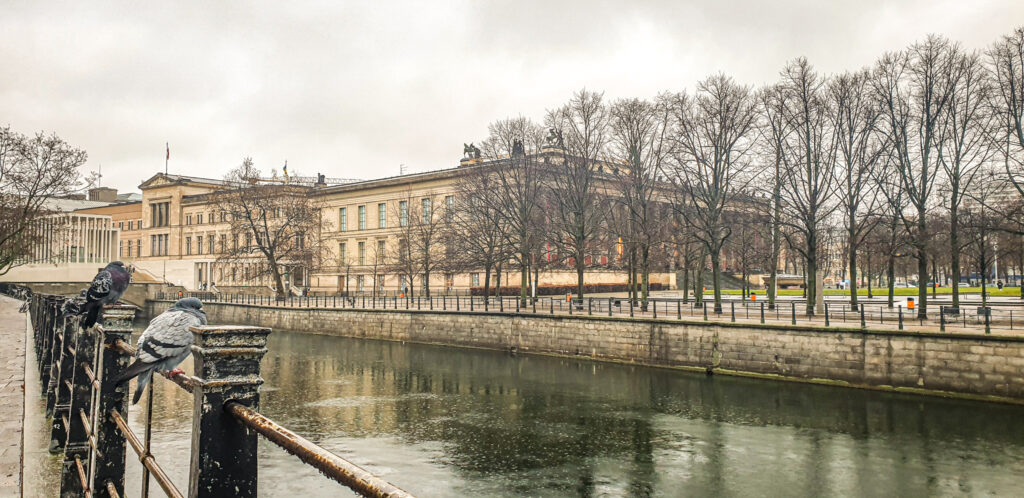
Berliner Dom
The Berliner Dom, or Berlin Cathedral, is as a testament to Germany’s architectural prowess and cultural grandeur. This Neo-Renaissance masterpiece is designed by Julius Carl Raschdorff. The Dom was consecrated in 1905. Its monumental presence on the banks of the River Spree not only serves as a place of worship but also as a symbol of Berlin’s endurance through tumultuous times.
The Berliner Dom’s design is a harmonious blend of architectural styles. It’s primarily Neo-Renaissance with touches of Baroque and Gothic elements. The dome is rising 116 meters above ground and dominates the cityscape. The Dom has mixed elements of the neo-baroque and neo-renaissance styles. The imposing silhouette is crowned by a magnificent copper dome. Its exterior is a work of art, with sculptural details and a columned façade that exudes grandeur and grace.
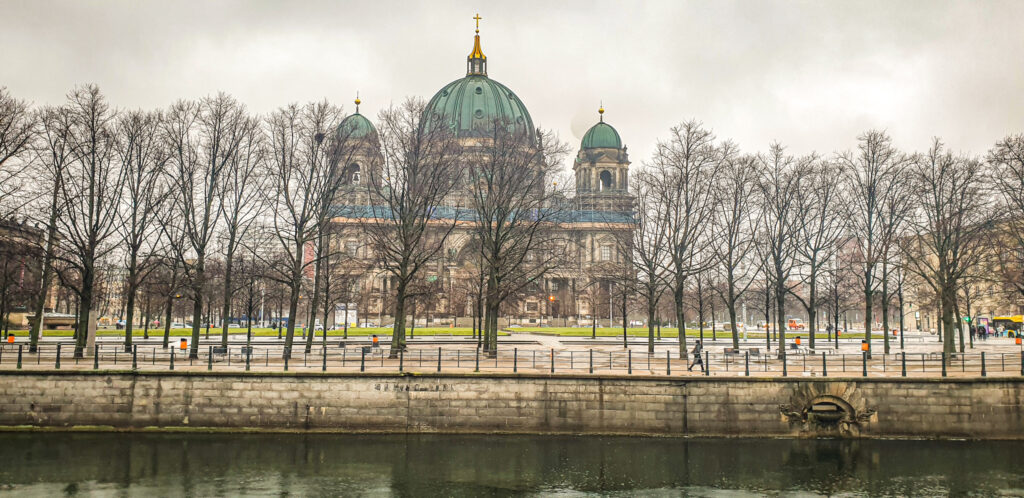
Humboldt Forum
The Humboldt Forum’s story go back to the 15th-century Berlin Palace, a royal residence for the Hohenzollern dynasty. The palace witnessed centuries of history, from the Prussian era to the German Empire, until its destruction during World War II. In a symbolic move after German reunification, the decision was made to reconstruct the historic Berlin Palace. The Humboldt Forum’s architecture is a fusion of the past and the present. It’s a blend of Baroque and modern glass structure. The result is a visually striking complex that pays homage to the palace’s heritage while embracing contemporary design.
At its core, the Humboldt Forum is a cultural institution that transcends traditional museum paradigms. It houses a diverse array of collections and exhibits, ranging from artifacts of global significance to contemporary artworks. The forum’s thematic focus on world cultures, science, and the arts creates a dynamic space where visitors can explore the interconnectedness of human history and creativity.
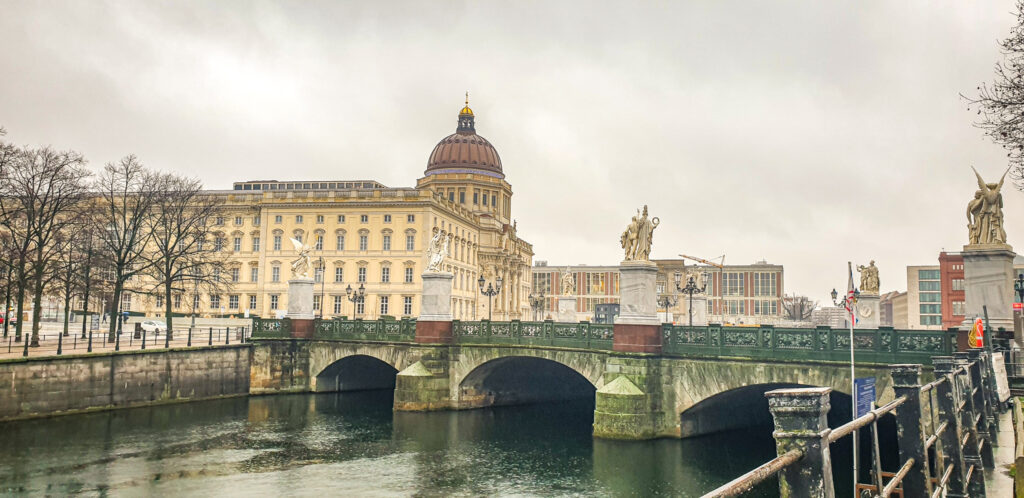
Charlottenburg Palace
One of the best monumental highlights to visit in Berlin is the Charlottenburg Palace. This palace was constructed in the Baroque style during the late 17th century and early 18th century. The palace was initially built for Sophie Charlotte, the first queen of Prussia, and her husband King Frederick I. They commissioned this grand palace after being inspired by the Palace of Versailles in France, which they had visited. The palace features a distinctive combination of French and German architectural styles.
The most impressive feature of Charlottenburg Palace is its central building. The building consists of two wings and a central dome. The central dome is decorated with a grand statue of the Goddess Fortuna at its pinnacle. The Goddess reflects the palace’s aspirations to greatness and success. Inside the palace, visitors can admire the Baroque-style rooms, exquisite decorations and furniture.
Charlottenburg Palace underwent significant renovations after it suffered extensive damage during World War II. Many of the palace’s treasures were destroyed during the war. But thanks to extensive restoration work the palace has been recovered to its former glory. One of the palace’s most notable highlights is the Golden Gallery. It features an extensive collection of paintings, tapestries and sculptures. They provide a glimpse of Berlin’s artistic history. Art lovers visiting the palace will find themselves immersed in a world of artistic culture.
Charlottenburg Palace Gardens
Visitors to Charlottenburg Palace will also get the opportunity to explore the palace’s lush gardens, which are spread across nearly 50 hectares of land. The gardens form a picturesque setting, where visitors can enjoy a peaceful stroll through the winding paths or have a picnic in scenic surroundings. The palace gardens are home to a stunning collection of flowers, shrubs and trees. And even several hidden fountains and charming statues.
Kaiser Wilhelm Memorial Church
The Kaiser Wilhelm Memorial Church is also known as the Gedächtniskirche in German. The church was built in the late 19th century under the orders of Kaiser Wilhelm II. The church was opened in 1895 and was dedicated to his grandfather Kaiser Wilhelm I. The building was heavily damaged during a bombing raid in 1943 that left much of Berlin in ruins. Rather than being demolished, the damaged spire was left standing. The decision was made to construct a new church building next to it.
The new church was completed in 1961. It is a striking modern building made of concrete. It features walls of stained glass and a ceiling decorated with thousands of chandeliers. The spire of the old church was incorporated into the design of the new building, creating a unique blend of old and new. The church complex also includes a Museum of the History of Berlin and a series of chapels, each dedicated to a specific theme. There’s a chapel of silence, a chapel of reconciliation and a chapel of light.
Memorial to the Murdered Jews of Europe
In the heart of Berlin lies the Memorial to the Murdered Jews of Europe. Also known as the Holocaust Memorial. This tribute stands as a solemn reminder of one of history’s darkest chapters. The Memorial is designed in 2005 by architect Peter Eisenman. The memorial has 2,711 concrete slabs of varying heights, creating a labyrinthine ambiance. As visitors you walk through the unevenly spaced pillars. The ground is uneven and it creates a feeling of disorientation and unease.
The abstract design of the memorial invites diverse interpretations. It enables each individual to connect with the profound tragedy of the Holocaust in a personal manner. Next to the memorial is an underground Information Centre offering historical context and personal narratives. Serving as an emotional commemoration of the atrocities inflicted upon the Jewish community, this memorial is a reminder to prevent the recurrence of such horrors.
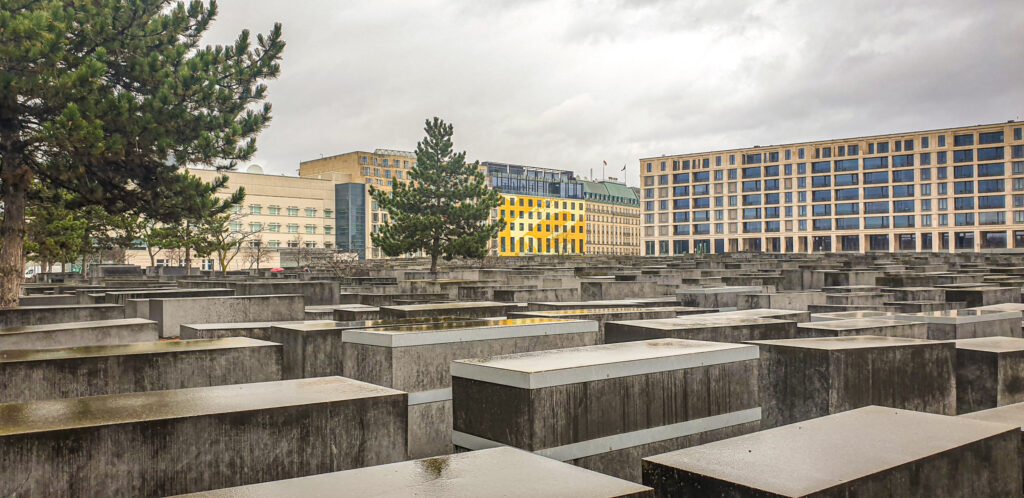
Soviet Memorial Treptower Park
I love showing people this monument, because no one ever expects how huge it is. Nestled within the scenic expanse of Treptower Park in Berlin, the Soviet Memorial stands as a monumental tribute to the Red Army soldiers. Unveiled in 1949 the memorial is a masterful work of Soviet architect Yakov Belopolsky and sculptor Yevgeny Vuchetich. At its heart lies the towering figure of a Soviet soldier. The figure is standing boldly over a defeated swastika. It symbolises the victory over fascism. The soldier cradles a rescued German child in one arm, a symbol of liberation and humanity prevailing over the ravages of war. It was once one of East Berlin’s top sights.
Friedrichshain-Kreuzberg
The Friedrichshain-Kreuzberg district was created in 2001 after the unification of two separate districts: Friedrichshain and Kreuzberg. Both of these districts had their own distinct histories. The merger brought together two different cultures that have since blended together to create a unique community. As a result visitors to Friedrichshain-Kreuzberg can admire a fascinating blend of east and west Berlin.
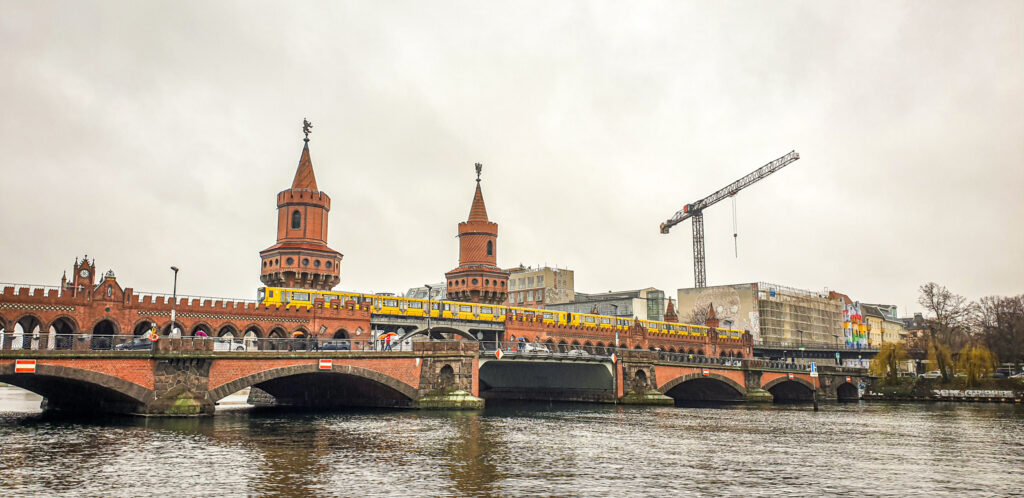
Friedrichshain
Friedrichshain was originally a working-class neighborhood that was largely destroyed during World War II. After the war the district was rebuilt and became home to young artists, bohemians and students looking for affordable housing. The area became known for its alternative culture, with squats, clubs, and galleries popping up throughout the district. Friedrichshain today is a bustling area known for its street art, flea markets, and vibrant nightlife.
Kreuzberg
Kreuzberg has a more diverse history that dates back to the 18th century. The district was originally a working-class area with a large Turkish community, which still remains a significant part of the local culture today. Like Friedrichshain, Kreuzberg has also been a hub of subculture and alternative lifestyles over the years, with the district becoming known for its punk rock scene in the 1970s and 1980s. Today, Kreuzberg is a trendy and multicultural area, with a thriving food scene, an abundance of green spaces, and a diverse population.
Friedrichshain and Kreuzberg are one of the most exciting and dynamic areas of Berlin. The district has played a significant role in shaping the cultural and political landscape of the city, with important historical events taking place in the area. The Berlin Wall ran through the district, with famous sections like the East Side Gallery situated in Friedrichshain. The district was also a center of political activism during the 1980s, with numerous protests and demonstrations taking place in the area.
The Friedrichshain-Kreuzberg district is a vibrant and eclectic neighbourhood that continues to attract visitors from all over the world. The area is home to a wide range of cultural events including theaters, cinemas, galleries, and museums. Visitors can also enjoy exploring the district’s many parks and green spaces, such as Görlitzer Park and Treptower Park.
Oberbaumbrücke
The Oberbaumbrücke connects the districts of Friedrichshain and Kreuzberg. This iconic double-decker bridge is a blend of Gothic and Renaissance revival styles. The bridge was constructed in the 19th century. The Oberbaumbrücke has endured the tides of history, surviving wars and political divisions. The bridge served various purposes over the years, from a border crossing point during the Cold War to a picturesque backdrop for films and cultural events.
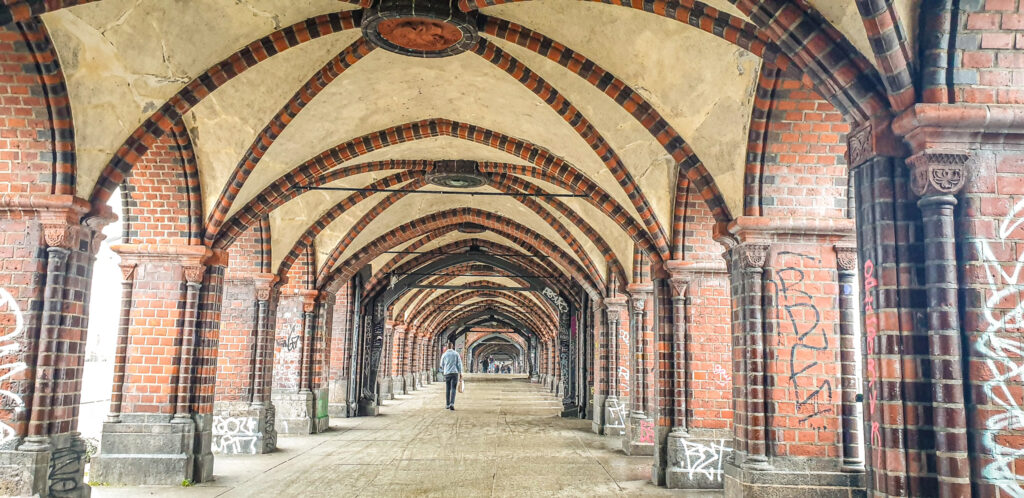
East Side Gallery
This open-air gallery transcends a once-imposing barrier, evolving it into a mesmerizing canvas where over a hundred international artists have left an enduring legacy. The East Side Gallery not only preserves the longest remaining segment of the Berlin Wall but also stands as the world’s lengthiest outdoor art exhibition. Stretching 1.3 kilometers, this vibrant masterpiece encapsulates the spirit of the reunification era. Each mural serves as a potent political statement, a compelling social commentary, and a poignant symbol. The artworks are a narrative about the struggles and hopes of a city liberating itself from the chains of division.
One of the gallery’s most iconic pieces is Dmitri Vrubel’s “Fraternal Kiss,” capturing the intimate embrace shared by Leonid Brezhnev and Erich Honecker. This painting, rich with political irony, symbolizes the warming relations between East and West.

Karl-Marx-Allee
In the heart of Berlin, Karl-Marx-Allee is as a testament to the architectural vision of the socialist era. Formerly known as Stalinallee, this iconic boulevard stretches over one kilometer. It is lined by imposing buildings that showcase the distinctive style of socialist classicism. Built during the post-war reconstruction period in East Berlin, Karl-Marx-Allee is a striking representation of the GDR’s commitment to monumental architecture.
The boulevard is lined with buildings characterized by their monumental scale, symmetrical facades, and ornate detailing. The grandeur of Karl-Marx-Allee was intentional, serving as a visual manifestation of the socialist ideology’s strength and permanence. The uniformity in architectural style along the boulevard creates a cohesive aesthetic, emphasizing the collective spirit of the time.
Jewish Museum
The Jewish Museu is designed by architect Daniel Libeskind. The museum tells a story of fragmentation, displacement, and resilience. Opened to the public in 2001, the Jewish Museum is not merely a repository of artifacts but an immersive experience that delves into the complex narratives of Jewish life in Germany.
Libeskind’s design is a symbolic masterpiece, featuring jagged lines, voids, and intersecting axes that evoke a sense of dislocation and rupture. The architecture intentionally challenges conventional museum structures. He invites visitors to navigate through spaces that mirror the emotional and historical dislocations faced by the Jewish people. The voids, or “Voids of Memory,” punctuate the building, each representing a chapter of Jewish history disrupted by the Holocaust.
The museum’s permanent exhibition unfolds across three underground corridors: Axis of Exile, Axis of the Holocaust, and Axis of Continuity. These thematic pathways guide visitors through a chronological and emotional journey, from the vibrant Jewish life in medieval Germany to the atrocities of the Holocaust and the post-war struggle for continuity.
Tempelhof Airport
The neo-classical terminal building was designed by architect Ernst Sagebiel. It was commissioned in the 1920’s but opened its doors in 1941. The airport’s design is an example of Nazi architecture, which sought to impress and to intimidate. The building was once the biggest in the entire world.
Tempelhof Airport holds a unique place in history as the site of the Berlin Airlift during the Cold War. When the Soviet Union blockaded West Berlin in 1948, Tempelhof became a lifeline, with Allied forces orchestrating an unprecedented airlift to supply the city. The airport’s importance during this crisis solidified its status as a symbol of freedom and resilience.
The massive airfield, once a bustling hub of activity, has witnessed significant historical events and transformations. Today, the airport, no longer operational for commercial flights, has been repurposed into a public park known as Tempelhofer Feld. The vast open space, framed by the imposing terminal building, invites Berliners and visitors to stroll, cycle, and engage in various recreational activities.
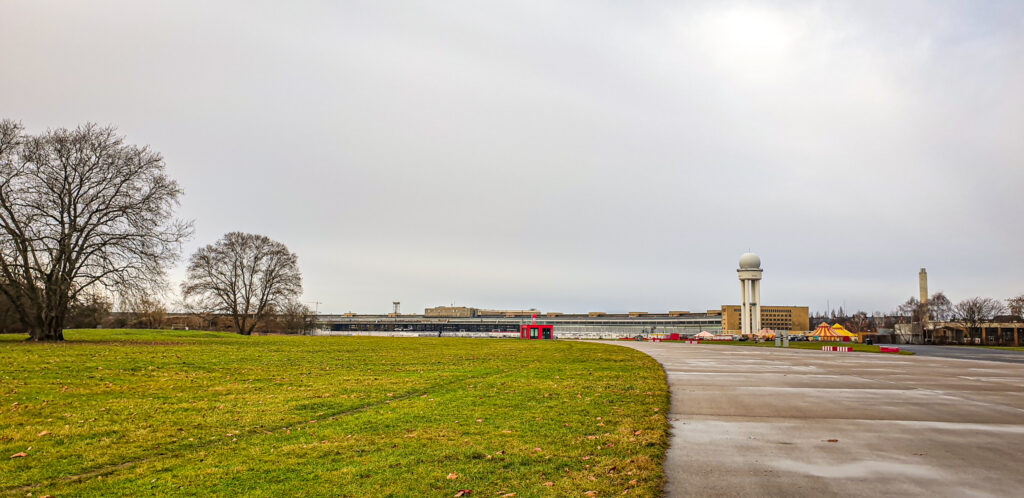
Private tours in Berlin
I’m Matti and a private tour guide in Berlin. Berlin’s size, its complex history, diverse neighbourhoods and attractions can be overwhelming. A private tour with a local guide ensures a personalized, curated experience, which also delves into the city’s hidden gems and untold stories. I would be happy to show you around when you visit Berlin. Visit my website to see what kind tours I have available: Tours of Berlin.
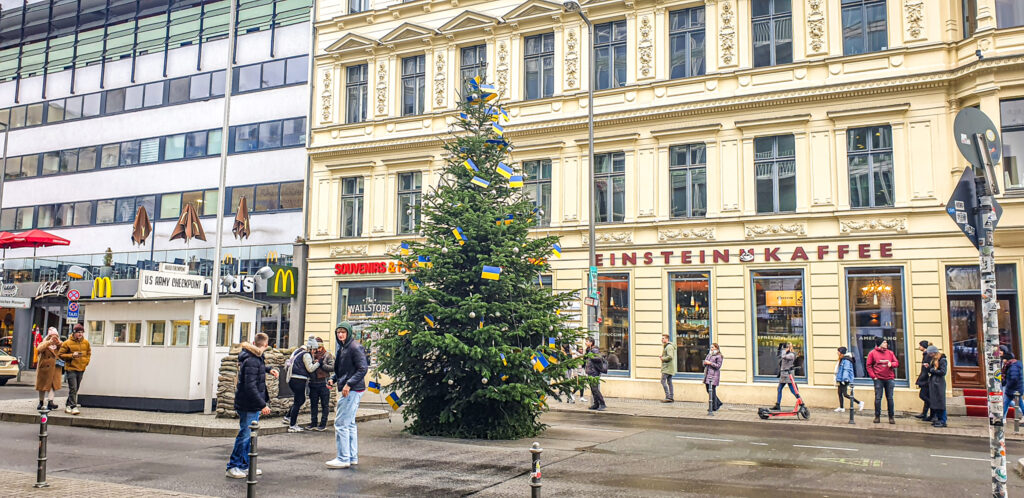
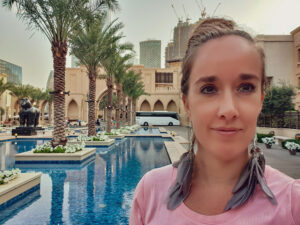

This Post Has 2 Comments
Leerzaam artikel met mooie foto’s
Hi Anita, Bedankt voor de toffe feedback. Adriana